The Windstorm of Thanksgiving 1983
Chapter # 1: The Beginning
Out in the Pacific sat a low that was rapidly moving toward the Oregon
Coast and was supposed to raise hell down there when its front hit.
The problem with this is that the low decided [heh] it would rather go
through Washington, and it veered northward. And boy, that sucker almost
moved right over us.
At 5 AM (the time I woke up) the pressure was reading 29.18" and
falling rapidly. In fact, the pressure was falling so fast I could watch
the needle move, just barely. That was the fastest pressure drop I have
ever seen.
I wonder if the weathermen thought that the rapid pressure drop would
mean that a windstorm was going to strike? They must've figured that the
low was still heading into Oregon because the weather report at the time
called for rain in the afternoon and winds of 10-20 miles per hour. But,
something at the time told me things would be different.
Well, at the time, the wind was gusting to 30 mph with occasional gusts
higher. The highest gust was about 33 mph. There seems to be an eerie calm
before one of our windstorms, like the one I remember that occurred before
the windstorm of Nov 14, 1981. Since it wasn't calm and the pressure was
falling I figured that if there was a storm, it wasn't going to hit quite
yet.
The sky at 5 AM was very dark, so I really couldn't tell what kinds of
clouds were up there, but I saw some clearings between the fast moving clouds.
I waited for awhile, listening to the weather-radio from time to time
to see if the report had changed. Nope. It hadn't., It was the same old
10-20 mph.
I wondered what they [the weather officials] were doing down there as
I watched the pressured drop to 29.10" at 6 AM.
The winds were still gusting to 30 mph, which meant their report was
wrong, even then.
When I looked at the sky in the very feeble light of dawn I saw some
stratus with larger clearings between them scudding across the sky. The
wind was roaring through the trees pretty loudly too.
The pressure was reading 29.00" at around 7 AM. It was the lowest
I had seen in more than a year and as things turned out, it would drop lower.
Finally there was light outside. I could see scraggly, fast-moving, stratus
clouds blowing toward the NE. They were really torn up and a blue sky showed
between them. Sometimes a large clearing would reveal high, fast-moving
cirrus clouds. The clearings were getting bigger as time progressed and
the wind didn't seem to be dying either.
The weather report was still the same.
Sometime between 8 and 9 two things happened.
The first thing that happened was that the pressure dropped to its lowest
and steadied at 28.94." Sea-Tac had 28.97" so I accept that as
the actual low because my barometer was probably a little off at the time.
Quillayute had a low of 28.80" and Astoria dropped to 28.88".
I'm sure when this happened the weathermen got a little worried.
The second thing that happened (I think at 9 or 9:30) was the weather-radio
alarm went off.
They gave us high wind warning for the western half of Washington.
That meant we were supposed to get winds of 20-40 mph with occasional
gusts higher within 12 hours. It was going to hit much sooner than 12 hours.
Finally they warned people and they were almost too late.
At the time the sky was mostly clear with occasional fast moving stratocumulus
clouds flying by with lots of white wispy cirrus clouds overhead. To the
south and west were more clouds but no sign of the front that I figured
should be moving on us fast.
The winds were still occasionally gusting past 30 mph so I figured I
had a long wait. But I stayed by my anemometer just in case there were any
surprises.
I noticed the air had a different quality to it. It seemed foggy or murky,
but it couldn't be foggy with this wind blowing. Another thing was that
the sun shone clearly and brightly through the clearings and it gave a weird
feeling around the place. There were no seagulls flying over to Lindburgh
High School or any other animal was not to be found. It was completely strange
and I will never forget it.
Chapter # 2: Strike!
At 10:00 AM I was sitting on the couch waiting for the windstorm to strike.
This was one of those rare time in which the windstorm occurred in the day,
not in the night, so I wouldn't fall asleep waiting and I could see what
was happening to the trees.
At this time, the skies and the winds were the same: partly cloudy and
gusts to 30 mph. The pressure stood at 28.94" and occasionally fluctuated
up to 28.95" or down to 28.93" every once in awhile.
It did not take long for me to find out another thing that was rare about
this windstorm.
There would be no calm before the storm.
At 10:10 the skies got cloudier. So I jumped up and ran to the master
bedroom and looked out the west-facing window. There were a bunch of small
stratocumulus clouds to the SW, a bit more packed together than the ones
over us and some high cirrus clouds were moving rapidly above the house.
The fronts usually came from the southwest and were usually proceeded by
a lot of altostratus clouds and I could only see one patch of it moving
rapidly to the north. I should've took this as a warning because this is
how I thought it would look like before a windstorm and I had even written
it down.
I ran back into the living room and listened to the weather report to
see if anything had changed: but nothing had. I noticed that it was darker
outside.
I got up and walked to the anemometer and looked out the window. A thickening
layer of dark stratus was overhead and it was moving fast.
I knew I would only have to wait just a little bit now. It seemed to
be upon us now.
At 10:15 AM the first part of the storm struck. It came in fast and deadly
(for insects) with the first two gusts at 37 and 36 miles per hour. A very
heavy rain poured down just as the gusts hit.
This happened very quickly and I was almost caught by surprise.
The rain poured down more heavily than any thunderstorm that I had seen.
It reminded me of a hurricane because the drops of rain were extremely large
and they whipped about in great white sheets that drenched everything in
seconds. Rain spattered all over the window [which was protected by a deep
eave] and the sheets blocked vision pretty well. Water was pouring everywhere
not too long after the storm hit.
While the rain came down from the medium grey sky, the wind did not blow
that strong. It mainly gusted between 30 and 40 mph.
Not too long after the 37 and 36 mph gusts I saw a 38 and then a 35 mile
per hour gust. About five minutes after the rain started two 39 mph gusts
and a 40 mph gust blew past. Then it gusted to 42.
For some people 42 mph may not sound like much, but any wind of 39 mph
or above is gale force and can cause damage (mainly to trees).
The trees had gone mad with all their leaves ripping off in great swarms
and branches bouncing and clashing noisily. Sometimes a large branch would
crack off and slam into the ground or on a roof.
The hemlock was swaying and bobbing about with all its south facing branches
pointing east and west as the wind hit them.
Between 10:20 and 10:30 AM the above weather continued, but with a little
more intensity. There wasn't any lull in the wind or rain and things were
weakening fast.
Around 10:30 something interesting happened: the power went out.
This did surprise me. The only other time a windstorm had knocked the
power out was on February 19, 1981, and that one was a powerful one, knocking
down four trees in our forest, one falling on a fence. Enough talking about
that one now, after all this is the Nov 24, 1983 windstorm.
The other problem about the power going out is that we had two pies in
the oven, and the question, "Can the work crews restore the power in
time to cook the turkey?" This was a major windstorm and the work crews
would be busy.
The wind continued to buffet the area and the rain continued to pour
down with its increased intensity until 10 to 15 minutes after the power
zonked out. That's when the rain started to stop, the clouds started to
thin, and the winds started to increase. A new peak gust roared by. It was
45 mph.
Then, the sky partially cleared and the stronger, steadier winds set
in. There was going to be some strong gusts now!
When the sky cleared, I tapped the barometer and it was 28.99" and
rising. Here come the winds, I thought.
We had all kinds of gusts into the forties which included a 44 mph gust.
Things began to get crazy now.
The cottonwoods were bent so far they looked like they were going to
fall. Their branches bent, snapped and clashed about in the gale.
The birches were doing the same, but they were a little straighter (because
the were smaller, had no leaves at the time, and were less flexible). But
they were losing twigs as fast as Dad spends money.
The alders just swayed and bounced about, occasionally losing a branch
in the gusts.
The hemlock was bent like a whip and all its south facing branches were
pointing north with the east and west facing branches. It looked as if someone
had sawed all the branches off but the north-facing ones.
After a while more of the brief gusty clearing grey stratus clouds set
in to cover the sky in a thick blanket. The winds continued strongly and
they were going to be at their strongest point soon. The power was still
out.
Since it was almost completely quiet because of no power, I could clearly
hear the wind roar through the trees like a jet. When the wind whistled
and whined past the house, it roared through the chimney like a lion. The
house creaked and cracked in the gusts and the balcony door shuddered in
the near 50-mile-per-hour gusts.
Every one in a while, the whole house would shudder as a long, steady
gust blew by. The windows would pulsate inward sometimes as if they were
going to shatter.
Leaves and twigs occasionally flew by the windows and a few landed on
our balcony.
I saw two 43 mph gusts and looked at the swaying trees and decided to
go to The Forest.
Chapter # 3: The Forest
I whipped on my coat, grabbed my air rifle (just in case), and picked
up that ol' tard, Alec [my small-standard dachshund]. Then I took one more
look at the anemometer as a large gust blew past. It reached 38 mph. I turned
around and headed for the door, quickly so I wouldn't want to run back to
the anemometer as another gust hit.
When I opened the door the wind blew in with a strong, cold gust. I walked
out and had a little trouble closing the door as the wind continued at gale
force. I finally yanked it closed.
When I got to the bottom of the stairs and turned south toward the low
rocks that lead to The Forest, the gusts hit me at their fullest and it
was very hard walking in the wind. At least it wasn't raining because if
rain was coming down in that kind of wind, it would sting like hail.
The small trees that were planted in front of the buildings swayed and
bounced in the gusts. The small brown street lamps bounced back and forth,
making little ticking sounds as they did so. Cottonwood leaves flew high
in the sky, swirling, flipping. Some of the leaves stuck to my coat.
When I reached the rocks I stopped and stared at the three cottonwoods
at the corner of the fence. Their tops were point directly northwest, and
they were whipping up and down like a sea-serpent moving through the water,
unbelievably. The only other time I had seen them sway like this was in
the gale of the 10th. Leaves tore off of the trees like birds, one by one,
or a while warm of them all at once.
I dropped Alec on the grass above the rocks and checked to see if my
air rifle was loaded. It was.
So I climbed up the rocks and saw Alec running up the hill, with his
ears down, of course (because of the roar). Then I turned east and walked
along the rocks, toward The Forest.
The apple tree (not too far from the edge of The Forest) was doing a
weird jig in the howler and the larger--if not biggest--cottonwoods were
in a steady, roaring sway as another of the many gusts whipped by.
Leaves and twigs blew by me as I approached closed to the forest. Already
trees were swaying to my right. Alec followed closely, running.
I entered the southern part of The Forest just as a huge gust hit. This
part of the forest had mostly birches and they bounced back and forth with
their branches clashing, some even snapping off to fly through the air and
land on the forest floor or into the street nearby. Some of the branches
sailed far enough to slam into one of the condo's roofs.
The nearby large cottonwoods continued to sway with a branch or two cracking
off now and then. One large one landed into a leaf pile. Another larger
branch smashed into a carport roof with a loud bang. Twigs landed silently.
I walked along the trail and noticed that a birch lost a huge branch
that was 5-6" in diameter and more than 10' long. It was lying in a
small sticker bush patch.
No trees had fallen--only large branches had cracked off. I had not checked
the northern part of the forest and I decided not to go yet. I could see
what happened later. So I turned around, with the wind a-roarin', and walked
home. Alec half walked half ran.
When I got home, I started to watch the anemometer and record various
40 mph gusts. Then one gust thundered across our roof. It registered 47
mph, the peak gust that I saw. I suspect the wind gusted higher--I had missed
some gusts when I went to The Forest, and Sea-Tac had a peak gust of 54
mph.
Another thing happened when I came home, too. The power zapped back on
at 11:45 AM. One hour and fifteen minutes later. We were going to have turkey.
After a while longer of watching the 40 mph+ gusts on the anemometer,
I decided to do another forest check.
This check revealed a few more large branches down and a birch tree snapped
in half in the northern part of the forest. It landed on a cedar wood fence,
doing no damage.
After that, I watched the dying gusts of the windstorm. The winds gusted
to and over 40 mph for four hours more and then it almost calmed down completely.
After about an hour of dead calmness, two blasting gusts struck. These would
be the last strong gusts of the storm. They registered 37 and 36 mph on
the anemometer. Interestingly, the storm had also started with a similar
set of gusts.
Chapter # 4: Destruction
Here are some of the things that happened during the windstorm:
First, around here:
An alder one and a half feet in diameter snapped at two feet above the
ground and landed on the eastbound lane of Puget Drive, doing no damage.
It just blocked the lane for an hour or two. Another smaller alder fell
nearby, but it did nothing.
A medium-sized alder in the Power Lines lost its top in the gale. When
the top hit the ground, it sank one foot into it, throwing mud every which
way, and then cracked in two.
Also in the Power Lines, a willow split at the four-foot-level and sheared
two other trees of some of their branches as it fell. Thus, only tree damage
was done.
During the wind, boards and such were blown about at the new construction
site at the Power Lines.
At my condo complex, an alder with huge branches lost one in the gale.
The branch was well over 30 ft long and about one foot in diameter. It almost
hit one of our condos and it split in three sections when it slammed into
the ground.
Second, other places...
At the [Renton Public] library huge 10-20 foot branches snapped off of
the nearby cottonwoods in the height of the storm. The branches slammed
into the roof of the library and landed all over the sidewalk, making ominous
crashes as they hit. There was a little fence damage.
One rather large alder came down at the Cedar River Park. It fell into
the swollen Cedar River and floated down stream.
At Seward Park [in Seattle], four trees fell along the nature trail.
One was a Douglas fir which snapped about 30 feet off of the ground. Another
one was a hemlock and one was a cedar. A silver maple did not fare too well
either. Along a branch in the trail a large birch gave way and smashed a
fence. So much for the fence.
At west Seattle, where the winds topped 60 miles per hour, there was
a lot of window damage and shingle damage. Most of the damage occurred to
the houses that were along the water front because the wind whipped 6-10'
swells which, of course, slammed into the houses.
At a nearby construction site, lots of boards were thrown about and got
imbedded into the ground or slammed into nearby houses. This did not help
the houses' windows either.
In some places in West Seattle the power was out for a day and a half.
At Seattle, a madrona--a very large one--fell and smashed a garage into
splinters and crushed a car. Some of its branches got imbedded into the
car's trunk and engine.
Also at Seattle, a Douglas fir cut a mobile home in two as it came crashing
down. No one was injured.
At Sea-Tac, where the winds gusted to 54 mph, a helicopter fell to its
side.
The Toledo airport had a hangar get damaged and three planes flipped
over. The winds there gusted to an estimated 70 mph.
All along the Sound telephone poles blew down and stop lights blew off
of wires. Lots of billboards were bent and twisted out of shape by the 60
mile-per-hour winds and a tree went down on almost every block.
The End | 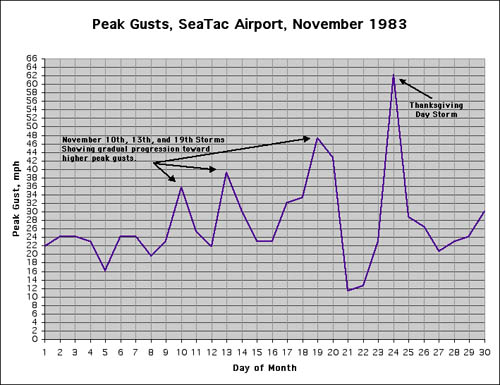

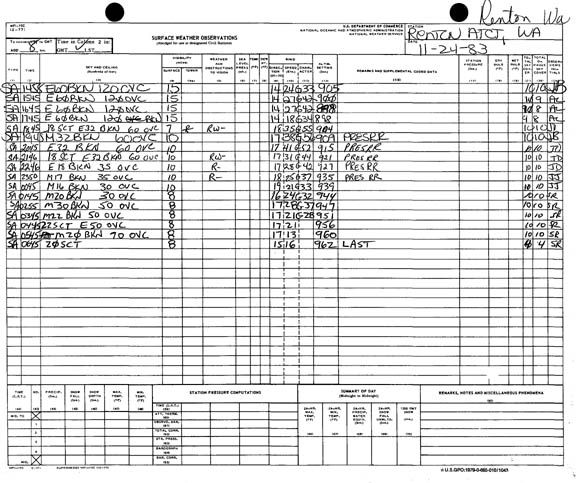
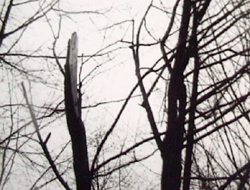 The photo to the left shows a red alder tree,
Alnus rubra, from the Power Lines region that lost its top in the
gale. This was a healthy tree. In a manner not atypical of alders, when
this tree broke, a large, pointed chuck sheared from of both the top and
bottom sections, then speared the ground--or, quite possibly, the top struck
the ground with such force that it caused its pointed end to shear off.
The spear was so firmly planted in the ground that I couldn't remove it.
This chunk, or "alder spear" as I often called them, is depicted
in the photo below.
The photo to the left shows a red alder tree,
Alnus rubra, from the Power Lines region that lost its top in the
gale. This was a healthy tree. In a manner not atypical of alders, when
this tree broke, a large, pointed chuck sheared from of both the top and
bottom sections, then speared the ground--or, quite possibly, the top struck
the ground with such force that it caused its pointed end to shear off.
The spear was so firmly planted in the ground that I couldn't remove it.
This chunk, or "alder spear" as I often called them, is depicted
in the photo below.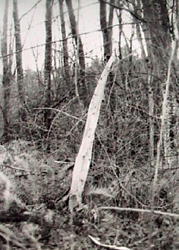 I've seen these spears a number of times--alders
broke similarly in the December 22, 1982 storm (which one day will be detailed
on this website), and the January 16, 1986 windstorm (in the latter case,
the poor tree produced two chunks!), for instance. I suspect the creation
of these spears must be a product of the nature of alder wood, for I have
not seen the development of these spears in birch, cottonwood, nor any of
the softwoods. It occasionally happens to bigleaf maples.
I've seen these spears a number of times--alders
broke similarly in the December 22, 1982 storm (which one day will be detailed
on this website), and the January 16, 1986 windstorm (in the latter case,
the poor tree produced two chunks!), for instance. I suspect the creation
of these spears must be a product of the nature of alder wood, for I have
not seen the development of these spears in birch, cottonwood, nor any of
the softwoods. It occasionally happens to bigleaf maples.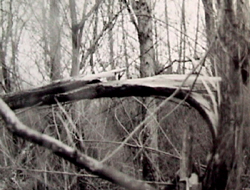 The photo at the lower right shows a broken
scouler willow, Salix scoulerana, from the same woodlot in the Power
Lines as the broken alder. Other nearby woodlots had no damage. It is not
too unusual to find broken trees concentrated in small regions, with little
damage between. Whether this is due to localized higher wind speeds, less
obstructed wind exposure, or a general weakness of the trees in one spot
due to disease or insect attack, I haven't determined. Though, it is conceivable
that all three of these ideas, and probably others, each play a role in
different storms. I'll write more about this when I cover the tree damage
from the January 1986 train of storms, for these systems produced some of
the most striking examples of damage localization I have seen, save maybe
for the December 28,1990 northerly gale in the Puget Lowlands (which will
also deal with this topic).
The photo at the lower right shows a broken
scouler willow, Salix scoulerana, from the same woodlot in the Power
Lines as the broken alder. Other nearby woodlots had no damage. It is not
too unusual to find broken trees concentrated in small regions, with little
damage between. Whether this is due to localized higher wind speeds, less
obstructed wind exposure, or a general weakness of the trees in one spot
due to disease or insect attack, I haven't determined. Though, it is conceivable
that all three of these ideas, and probably others, each play a role in
different storms. I'll write more about this when I cover the tree damage
from the January 1986 train of storms, for these systems produced some of
the most striking examples of damage localization I have seen, save maybe
for the December 28,1990 northerly gale in the Puget Lowlands (which will
also deal with this topic).